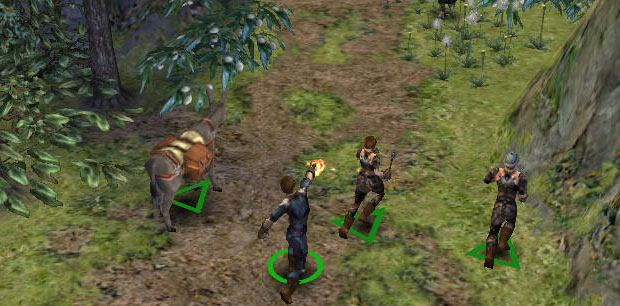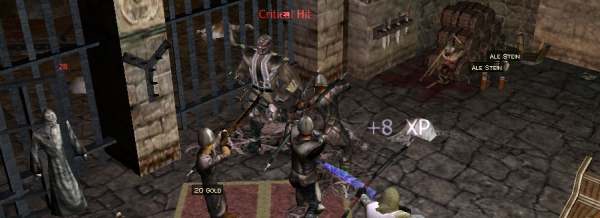The Making Of: Dungeon Siege
[When thinking about which post-mortem to lob up when I was away, this one struck me as most appropriate. Since I'll actually be at Gas Powered games during my awayness, Dungeon Siege seems like a good idea. I give a little of the context in the piece itself, but it was wayyyy into the evening and the booze was getting to both Chris and myself, crouched around the Dictaphone and both saying things we really shouldn't (very few of which had anything to do with videogames). Chris Taylor is an effusive bloke, to say the least. Worth noting that this was done prior to DS2's launch, and before Supreme Commander was even vaguely revealed.]
We find ourselves at a glamorous Microsoft press-event in San Francisco. “Glamorous” being code-words for “There is alcohol here”. They’ve gathered their sharpest minds to introduce their typically polished portfolio for the next twelve months, so are presented to the gregarious and effusive Chris Taylor. We start getting nervous, with images of epic mechanical destruction clouding our otherwise purely objective minds.
We try to leave before we start gushing about how much we loved Total Annihilation, only to see Brian “Rise of Nations” Reynolds in the opposite direction. Oh no. Pincered by two genuinely great RTS developers. There’s only one thing for it: start asking questions about how Dungeon Siege came to be and what he learned from it. Because while it’s an undeniably splendid game, it’s also a game that which we’re slightly more capable of keeping a little journalistic distance. An interview about how CUTE the Commander is won't be of much use to anyone.
Dungeon Siege was one of the more interesting games in the RPG-game sub-genre in the last five years. In some ways, it’s easy to see it as a mirror-image to what Blizzard originally planned to do with Warcraft III. While they were trying to take a real-time strategy game and turn it into a role-playing game, Gas Powered Games were doing the opposite – taking an RPG and turning it into an RTS game. While both backed off from the furthest reaches of the experiment, there was enough of the genetic material passed over to distinguish them. In the case of Dungeon Siege, a RPG that was all about larger-than-expected groups fighting it out in a way so driven and action-based that it made Diablo look like the narrative-heavy Planescape Torment. There was a Dungeon. And there was a Siege of it. It all kinda kicks off from there.
“We were really big fans of Diablo,” explains Chris when asked to explain where the concept for Dungeon Siege came from, “We really enjoyed that. In our business, we really do build on games ideas from one to the next. So if we see a game we really like we try and work out ways to improve it. When I saw Diablo, I was like “Awesome!”. Because I didn’t even know there was a market for that kind of game. I played Wizardry back in the 80s, and I loved it. But what happens is if no-one makes a game we don’t know if anyone wants to buy it. So we sometimes think a genre is dead. When Diablo was successful it was like: “AWESOME! Let’s build an RPG game… and let’s really go after the things which we think make RPGs great.” That is, exploration. Cool loot. Fantastic spells, and all that kind of thing.”
“We started there, and then decided that we wanted to go into 3D,” he continues, “We wanted to innovate in terms of experience, reduce some of the micro-management and make the game a little more strategic orientated with less of a click-fest.” Not that a more hands-off approach proved universally popular. “Some of the people criticised and said that the game played itself,” Chris explains.
Technologically speaking, the most distinctive element of Dungeon Siege was how it streamed its levels. Throughout the huge world, there wasn’t a single loading pause. “When you’re in a fantasy game…” Chris reaches for a metaphor to explain why this is so important, “Well, imagine if it’s a movie, and if you have to change the film every ten minutes, you wouldn’t be able to immerse yourself into the Fantasy. By eliminating loading screens we were able to keep people in the game, and much more immersed in this world. You become one with the game. You could melt into the monitor and the keyboard and the mouse.”
Essentially, this technology is about being able to stay inside the game. Chris carries the approach to game design as a whole. “It means we look for things which ruin a perfectly great experience… and we try to eliminate them. That’s what we do.” He grins, “We’re trying to make it as perfect we can. If it was a film, and the film kept breaking, we’d make stronger film. As soon as we had strong film that never broke, we’d try to improve colour or all the things which happen traditionally with any kind of technology entertainment medium. We’re always trying to improve the experience.”
This attention to detail lead to innovations across the game, from large scale elements like the streaming to detail like being able to resell items for full price and the ever-handy equipment-carrying mules. Not that attention to these places didn’t have a cost. “What we were unfortunately unable to do was working on the story, the characters backgrounds, the depth of the world… because we had built the technology and had to quickly build the game on top of the technology,” Chris elaborates, “These are very discrete stages. So it was hard to do, especially at a start-up company, building a new team from scratch with a crazy new technology and all of our tools”.
What is Chris most proud of? “It was the way that you could go from an outside environment to an inside environment seamlessly,” he explains, focusing in on a specific use of the streaming tech, “The world would just fade away, and you’d be in a dungeon. Characters could still be chasing you from outside as you go into the dungeon, and how the elevators all work. You could go down into a dungeon, monsters could come onto the elevator, you could throw the switch and be riding the elevator back up fighting on the platform with no restrictions or exceptions. It was all on. Everything was all on, working exactly the way you’d imagined it, with no kooky exceptions to the rules. It just all worked”
“Most disappointed that we couldn’t work a proper teleport system,” he continues, looking at the down side, “You’d be out in the world, and couldn’t quickly return to town. You had to hump it to the next town. The continuous world technology was so complex, we couldn’t find a really efficient way – or a way at all, with the time we had – to create teleportation. We have that in Dungeon Siege 2, but we just didn’t have the time then.”
It’s a rule of games development. You concentrate in one area, and you lose time in another. You can’t have everything. “It’s painful. We sold over a million copies of Dungeon Siege, but it had a pretty serious missing piece which we just did not have the time to add,” Chris laments, before finding the bright side, “Dungeon Siege 2 has it all. It has everything we wanted from the first game, so we’re pretty excited.”







